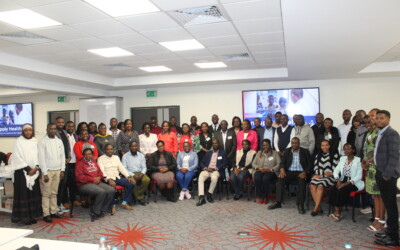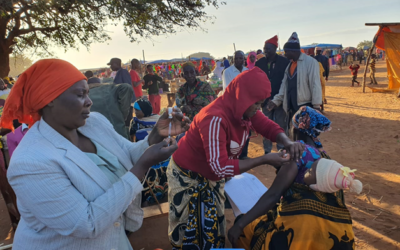To establish a sustainable pathway towards profitability in delivering high-quality family planning (FP) services through the private sector, it is imperative to strategically segment the FP marketplace, ensuring access and diverse methods of choice of contraceptives for women and girls. Understanding the barriers that make private community pharmacies an underutilized delivery channel for FP is a critical step in developing appropriate solutions that may expand access and provide discreet and convenient FP options. inSupply engaged with pharmacies and clients and, in partnership with the Kenya Medical Research Institute (KEMRI), Pharmaceutical Society of Kenya (PSK), Kenya Pharmaceutical Association (KPA) and University of California, San-Francisco (UCSF), used a human-centred design (HCD) approach to understand key issues surrounding the provision of quality FP services through this channel.

Here are some key findings from our research:
Pricing, Market Coordination, and Decision-Making in FP Services
While it may seem intuitive that empowering pharmacists and pharmaceutical technologists to offer FP services would broaden their product and service offerings, leading to increased sales and profitability, our design and implementation experience with pharmacy personnel, including owners and clients, presents a contrasting perspective. It unveils the intricate dynamics of pricing, market coordination, and the diverse decisions made by pharmacy personnel and clients.
Pharmacies’ prices for quality FP counselling and services may be motivated by multiple factors, such as a desire to maximize profit, altruistic motivations to help community members in need, or a desire to have competitive prices. This implies that pharmacy pricing may not be consistent across entities, and the lack of consistency may be dictated by supply changes and a pharmacy’s business approach. Adding to the complexity, pharmacists and pharmaceutical technologists face the challenge of limited access to dependable market data sources, necessitating their thorough examination of information before making decisions regarding the inclusion of new FP products in their inventory. Presently, these data sources comprise interactions between pharmacy personnel and product information from medical representatives, as well as anecdotal evidence of client demand. Even with anecdotal client demand information, it is difficult for pharmacies to predict the future because clients come into the pharmacy with different preferences for buying generic or branded products based on their financial status and desired social status perception.
Most clients were not price sensitive and were willing to pay Ksh. 500 (approx. $3.5) for a high-quality contraceptive option (DMPA-SC in this case). However, there was a significant increase from Q1 to Q2 responses in the number of clients willing to pay between Ksh. 150 and Ksh. 250 ( approx. $ 1-1.5).

Quality Concerns, Client Expectations, and Profit Maximization in Pharmacy Services
Achieving a harmonious balance between running a profitable pharmacy and effectively meeting client needs is a critical objective. Insights gained through our design and implementation process have unveiled persisting concerns regarding the pharmacy’s motivation and capability to fulfill each client’s distinct FP requirements in a professional manner. Some clients and stakeholders responsible for overseeing FP services at public healthcare facilities express doubts about the quality of contraceptive counselling and related services offered by pharmacies compared to those provided by public hospitals and medical clinics. Women are particularly attuned to potential side effects associated with contraceptives, often gravitating towards options with minimal or no side effects. Regrettably, in certain instances, clients who experience side effects from their chosen contraceptive tend to attribute blame to the service provider, who happens to be a pharmacist or pharmaceutical technologist. Our HCD results highlight the discouraging impact of such negative feedback on pharmacists, dissuading them from stocking FP products and delivering necessary services to women in need, perpetuating an unfortunate and self-reinforcing cycle. Additionally, pharmacists frequently encounter challenges posed by clients who arrive at the pharmacy with preconceived notions about the specific contraceptive method they believe aligns with certain aspects of their identity at that particular moment, demonstrating a narrow focus.
Pharmacies face a fundamental business objective: generating profit. Behind the scenes, these retail establishments are diligently strategizing how to attain their pursued goals. Typically, their endeavours to broaden their services are driven by the desire to attract more clients and boost sales through product bundling. In terms of service expansion, pharmacies are incorporating supplementary business offerings such as mobile money services to augment foot traffic and income. By doing so, pharmacies aspire to acquire clients who will also engage with other services provided by the pharmacy through these additional channels. However, when it comes to selecting which clients to prioritize, particularly in busy pharmacies, some opt to focus on those who are more lucrative by prioritizing non-contraceptive clients, especially during peak hours, as they require less time and yield greater profitability.

Gender Dynamics, Confidentiality, and Inclusive Access in Pharmacy Services
Women who frequent pharmacies demonstrate a willingness to pay premium prices for self-care products available at their local establishments, as they perceive these products to be of superior quality and capable of enhancing their well-being. While ensuring confidentiality during contraceptive counselling is universally valued by women, our design and implementation work has unveiled a range of preferences regarding the ideal age and gender of the pharmacist conducting the counselling. While most women prefer a pharmacist of their own age, some women feel more comfortable discussing contraception with male pharmacists, while others prefer female pharmacists. Notably, when women seek self-care products and contraceptive services, particularly emergency contraceptive pills, they often send their partners to purchase these items due to a perceived sense of judgment when inquiring about sexual reproductive health themselves. Young clients, in particular, face challenges in obtaining accurate sexual and reproductive health information when faced with disapproval or stigma from family members, pharmacists, and the broader community regarding their sexual activities. While men are frequently overlooked as significant consumers of FP services, our design and implementation work sheds light on their critical role in assisting their partners in accessing these services. Men commonly visit pharmacies for specific purposes, such as procuring emergency contraceptive pills for their partners, engaging in FP discussions with both their spouse and pharmacist or availing themselves of mobile money services conveniently provided by many pharmacies.
Most clients (33%) stated that convenience was the primary reason for seeking FP at a pharmacy rather than a clinic.

Conclusion
In light of the prolonged history of contraceptive donations and the resultant market distortions, it is imperative to identify viable and sustainable business solutions that incentivize pharmacy owners to consistently stock and sell contraceptives. This endeavour necessitates a strong focus on understanding the comprehensive self-care needs of clients. Moreover, it requires a profound grasp of specific strategies to enhance the value proposition of a self-care basket that includes contraceptives. As Kenya and other countries transition to middle-income status, governments must explore strategies that ensure emerging middle-class women, who have the financial means to pay for FP services, have access to FP care. Presently, Kenya heavily relies on the public sector for FP services and supplies, with nearly three-quarters of modern contraceptive users accessing these resources from the public sector. Furthermore, approximately half of FP users from the highest income quintile also rely on the public sector. Consequently, ensuring greater access for women who desire and can afford these services necessitates understanding how to leverage pharmacies as an underutilized channel to promote accessibility.
Learn more about the project here


